How To Make Sauerkraut: Sauerkraut is not just a delectable dish; it’s also a wonderfully healthy and nutritious fermented food that you can effortlessly prepare in the comfort of your kitchen. In this comprehensive guide, we will take you on a journey through the art of crafting sauerkraut, breaking down the process into six straightforward steps. Whether you’re new to fermentation or a seasoned expert, this guide has something for everyone. We’ve compiled a wealth of valuable insights, tips, and tricks to help you master the craft of sauerkraut creation and elevate your culinary skills.
The following sections will explore each step in detail, giving you a complete understanding of the sauerkraut-making process. From preparing the cabbage to the final stages of fermentation, we will walk you through each phase, ensuring you have the confidence to embark on your sauerkraut-making journey. So, whether you’re a curious beginner or a seasoned pro, let’s get started on this flavorful and nutritious adventure, and together, we’ll create sauerkraut that you’ll be proud to share with friends and family.
How To Make Sauerkraut: 6 Simple Steps
Step 1: Gather Your Ingredients
To begin your sauerkraut-making adventure, the first step is to gather all the necessary ingredients and equipment:
Cabbage: You’ll require a medium-sized head of cabbage. Look for a fresh and firm cabbage, preferably organic.
Non-Iodized Salt: Use between 1.5 to 2 tablespoons of non-iodized salt. This type of salt is essential for successful fermentation.
Large Mixing Bowl: A spacious mixing bowl is needed to prepare and season the cabbage.
Sharp Knife: A sharp knife will help you cut the cabbage into thin shreds with ease.
Cutting Board: Place your cabbage on a clean cutting board to avoid making a mess and ensure safe cutting.
Mason Jar or Fermentation Crock: You’ll need a container to ferment your sauerkraut. A mason jar or fermentation crock works well for this purpose. Keep reading to know more about How To Make Sauerkraut.
Also Read:- Best Healthy Late Night Snacks
Step 2: Prepare the Cabbage
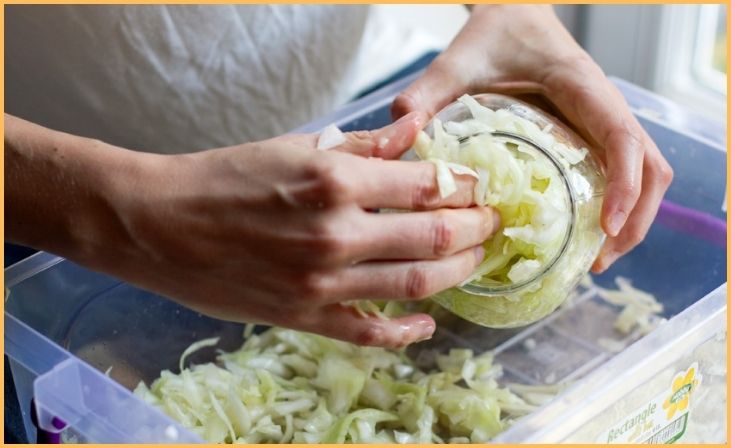
Now that you have your ingredients ready, it’s time to start preparing the cabbage:
- Begin by removing the outer leaves from the cabbage and setting them aside.
- Next, rinse the cabbage under cold running water to remove any dirt or impurities.
- After rinsing, place the cabbage on your cutting board.
- Using your sharp knife, carefully slice the cabbage into thin shreds. You can adjust the thickness to your preference, but a typical width is around 1/8 to 1/4 inch.
- Sprinkle 1.5 to 2 tablespoons of non-iodized salt evenly over the shredded cabbage.
- Here comes an essential part of the process: massage the cabbage with the salt. Use your hands to squeeze and knead the cabbage. This action will soften the cabbage and encourage it to release its natural juices. This liquid is what will create the brine needed for fermentation. Continue massaging for about 5 to 10 minutes until you notice the cabbage has become noticeably softer, and liquid starts to pool at the bottom of the mixing bowl.
Step 3: Pack the Cabbage
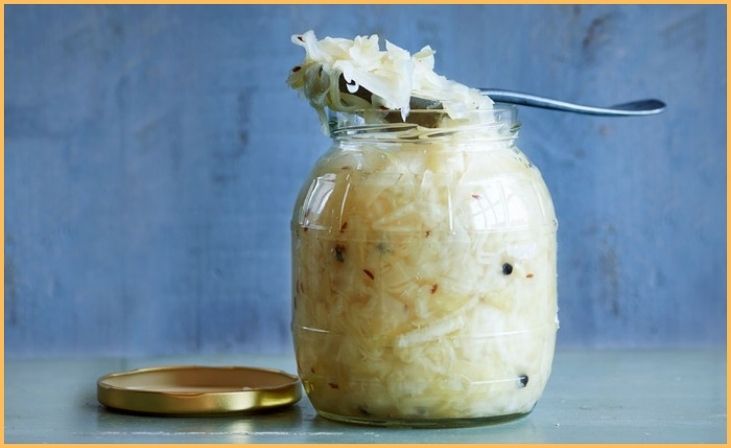
With the cabbage now seasoned and releasing its liquid, it’s time to move to the next step:
- Take handfuls of the salted cabbage and pack them into your mason jar or fermentation crock.
- As you add the cabbage, use a tamper or even your fist to press it down firmly. The goal is to eliminate any air pockets that might be trapped within the cabbage. The key to successful fermentation is ensuring that the cabbage is submerged in its own brine.
- Continue this process of adding cabbage and pressing it down until all the cabbage is packed into the container.
- The liquid released from the cabbage should rise and cover the cabbage completely. This is crucial for preventing spoilage during fermentation. Continue scrolling through to know more about How To Make Sauerkraut.
Step 4: Use a Weight
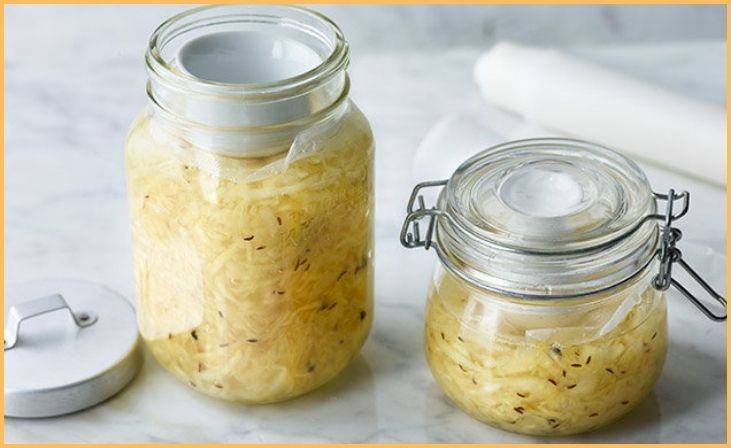
Ensuring that the cabbage remains submerged in the liquid is vital for a successful fermentation:
- To achieve this, you need a weight. This can be a clean, food-safe object like a smaller jar filled with water or even a zip-lock bag filled with water. The purpose is to keep the cabbage compressed beneath the brine.
- Place the weight on top of the cabbage within your container. It should fit snugly and press the cabbage down, so it’s fully immersed in the brine.
Step 5: Cover and Ferment
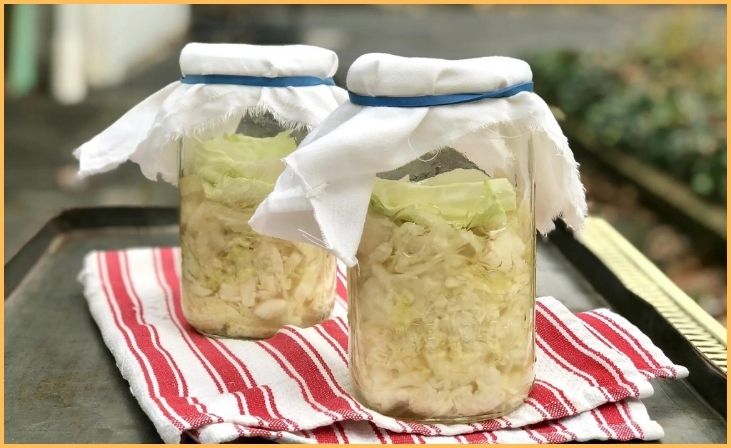
Now that your cabbage is prepared and weighted, it’s time to initiate the fermentation process:
- Cover the container with a lid if you’re using a mason jar or with a cloth secured with a rubber band if you’re using a fermentation crock.
- Store the container in a cool, dark place. The ideal temperature for fermentation is around 65-75°F (18-24°C).
- Fermentation times can vary, but you can expect the sauerkraut to be ready in 1 to 4 weeks, depending on your taste preferences. Be sure to check it periodically. Read more about How To Make Sauerkraut.
Step 6: Enjoy Your Sauerkraut
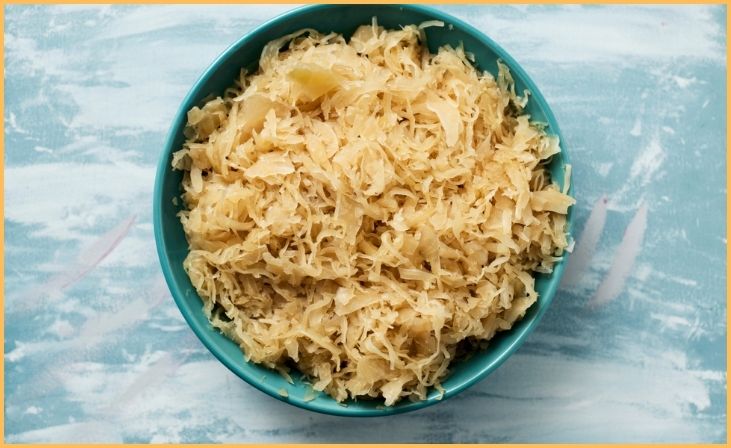
Once your sauerkraut reaches the desired taste, it’s time to savor the fruits of your labor:
- At this point, your sauerkraut has transformed into a tangy, flavorful delicacy.
- Transfer it to the refrigerator to slow down the fermentation process and maintain the sauerkraut’s freshness.
- Now, your homemade sauerkraut is ready to enjoy! It can be a delightful accompaniment to various dishes, adding a burst of flavor and the benefits of probiotics to your meals.
Conclusion
How To Make Sauerkraut: The process of making sauerkraut is not only straightforward but also incredibly rewarding. With just six simple steps, you can embark on a culinary journey that results in your very own batch of sauerkraut, teeming with deliciousness and health benefits.
As you follow these steps, you’ll come to appreciate the satisfying transformation that cabbage undergoes during fermentation. From the initial preparation to the patient waiting during the fermentation period, each stage offers a sense of accomplishment. And when your sauerkraut is finally ready, the joy of tasting your homemade creation is unparalleled.
One of the best aspects of sauerkraut making is the room it allows for experimentation. You can add your unique twist to the classic recipe, introducing flavors that suit your palate. From incorporating various spices to mixing in other vegetables, your sauerkraut can become a reflection of your personal taste and creativity.
Frequently Asked Questions
Yes, it’s safe to eat sauerkraut with surface mold. Just remove the affected parts, and the rest is good to go.
Absolutely! Experiment with carrots, radishes, or other vegetables to create unique sauerkraut blends.

